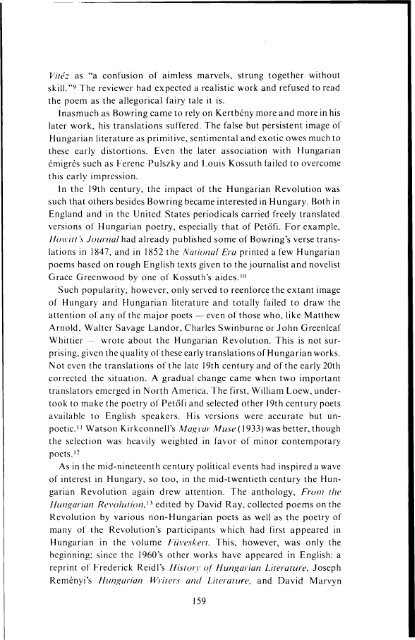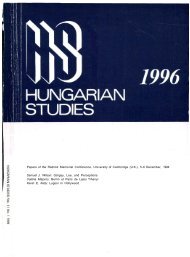limitations <strong>of</strong> Bowring and others: their inability to overcome the "becsispanyolfal, amelyre 'Mikosch' vagy 'Ungar Janosch' torzkepe voltrafestve." 6 Bowring had to depend on Carl Georg Rumy, Ferenc Toldyand finally, on Karl Maria Kertbeny for his information. Not knowingany <strong>Hungarian</strong> himself, he used the German anthologies published bythese men, or he obtained German versions <strong>of</strong> <strong>Hungarian</strong> songs. Sincethese sources were not critical in their selections, and since the Germantranslations were <strong>of</strong>ten inaccurate, Bowring and the others formed adistorted picture. Admittedly, the exoticism <strong>of</strong> <strong>Hungarian</strong> literature,real or imagined, was emphasized in the English versions. This is whatthe readers expected, and this is what they were given. As Hankiss hasstated, "A muvelt kiilfoldi ragaszkodik a magyar taj idilli zartsaganak,ember es fold szoros osszetartozasanak foltetelezesehez." 7As early as 1827 Bowring published one <strong>of</strong> Sandor Kisfaludi's "folksongs"in the May issue <strong>of</strong> the Monthly <strong>Review</strong>. Undoubtedly, he wasworking from one <strong>of</strong> the many German anthologies or periodicals thatcarried numerous examples <strong>of</strong> the suddenly popular "Magyar" folksong.Later. Bowring turned to Georg Rumy's Magyarische Antho/ogieas a source. It is ironic — and was unfortunate for the acceptance <strong>of</strong><strong>Hungarian</strong> literature in Western Europe — that these sources representedthe "distortions" rather than the true poetry <strong>of</strong> Hungary. <strong>The</strong>yemphasized the sentimentality and exoticism <strong>of</strong> Pre-Romanticism at atime when both <strong>Hungarian</strong> writers and European tastes had progressedbeyond this. Consequently, while Pet<strong>of</strong>i and his friends fought againstthe cheap success <strong>of</strong> unrealistic and sentimental verse, it was preciselysuch poems that became known abroad as <strong>Hungarian</strong> literature.<strong>The</strong> ambiguous or divided response to <strong>Hungarian</strong> literature canperhaps best be illustrated by the reactions to specific works. Bowring'sPoetry <strong>of</strong> the Magyars, for example, received generally good reviews.<strong>The</strong> quality <strong>of</strong> the translations was uneven, the selection was stronglyinfluenced by popular taste, but the introductory essay on the Magyarlanguage and the estimate <strong>of</strong> <strong>Hungarian</strong> literature was surprisinglyaccurate. Yet, though interest in the book was lively enough, it failed tohave any real impact. This occurred chiefly, 1 believe, because enthusiasmfor things <strong>Hungarian</strong> was mostly emotional, based on Englishsympathies for the Revolution <strong>of</strong> 1848 49. Such emotional commitmentshad a counter-effect, too: Frazer's Magazine, departing from thegeneral trend <strong>of</strong> eulogy, published a review slanted at least as severely inthe negative direction which illustrated its thesis by citing garbled lettersequencespurporting to be the <strong>Hungarian</strong> text. 8 Similarly, the Athenaeumdisplayed prejudice or at least ignorance when it spoke <strong>of</strong> Janos
Vitez as "a confusion <strong>of</strong> aimless marvels, strung together withoutskill." 9 <strong>The</strong> reviewer had expected a realistic work and refused to readthe poem as the allegorical fairy tale it is.Inasmuch as Bowring came to rely on Kertbeny more and more in hislater work, his translations suffered. <strong>The</strong> false but persistent image <strong>of</strong><strong>Hungarian</strong> literature as primitive, sentimental and exotic owes much tothese early distortions. Even the later association with <strong>Hungarian</strong>emigres such as Ferenc Pulszky and Louis Kossuth failed to overcomethis early impression.In the 19th century, the impact <strong>of</strong> the <strong>Hungarian</strong> Revolution wassuch that others besides Bowring became interested in Hungary. Both inEngland and in the United States periodicals carried freely translatedversions <strong>of</strong> <strong>Hungarian</strong> poetry, especially that <strong>of</strong> Pet<strong>of</strong>i. For example,Howitt '.v Journal had already published some <strong>of</strong> Bowring's verse translationsin 1847, and in 1852 the National Era printed a few <strong>Hungarian</strong>poems based on rough English texts given to the journalist and novelistGrace Greenwood by one <strong>of</strong> Kossuth's aides. 10Such popularity, however, only served to reenforce the extant image<strong>of</strong> Hungary and <strong>Hungarian</strong> literature and totally failed to draw theattention <strong>of</strong> any <strong>of</strong> the major poets — even <strong>of</strong> those who, like MatthewArnold, Walter Savage Landor, Charles Swinburne or John GreenleafWhittier — wrote about the <strong>Hungarian</strong> Revolution. This is not surprising,given the quality <strong>of</strong> these early translations <strong>of</strong> <strong>Hungarian</strong> works.Not even the translations <strong>of</strong> the late 19th century and <strong>of</strong> the early 20thcorrected the situation. A gradual change came when two importanttranslators emerged in North America. 1 he first, William Loew, undertookto make the poetry <strong>of</strong> Pet<strong>of</strong>i and selected other 19th century poetsavailable to English speakers. His versions were accurate but unpoetic."Watson Kirkconnell's Magyar Muse (1933) was better, thoughthe selection was heavily weighted in favor <strong>of</strong> minor contemporarypoets. 12As in the mid-nineteenth century political events had inspired a wave<strong>of</strong> interest in Hungary, so too, in the mid-twentieth century the <strong>Hungarian</strong>Revolution again drew attention. <strong>The</strong> anthology. From the<strong>Hungarian</strong> RevolutionJ 1 edited by David Ray, collected poems on theRevolution by various non-<strong>Hungarian</strong> poets as well as the poetry <strong>of</strong>many <strong>of</strong> the Revolution's participants which had first appeared in<strong>Hungarian</strong> in the volume Fiiveskert. This, however, was only thebeginning; since the 1960's other works have appeared in English: areprint <strong>of</strong> Frederick Reidl's History <strong>of</strong> <strong>Hungarian</strong> Literature, JosephRemenyi's <strong>Hungarian</strong> Writers and Literature, and David Marvyn
- Page 1 and 2: Canadian-American Review of Hungari
- Page 3 and 4: Canadian-American Review of Hungari
- Page 5 and 6: Canadian-American Review of Hungari
- Page 7 and 8: Canadian-American Review of Hungari
- Page 9 and 10: the best possible settlers who woul
- Page 11 and 12: than a decade later they were follo
- Page 13 and 14: Sociologists have yet to explain sa
- Page 15: fifteen minutes, and spent the rest
- Page 18 and 19: from the "Canadian poetry" of Icela
- Page 20 and 21: garian community of Western Canada,
- Page 22 and 23: lowed translations from other, more
- Page 24 and 25: which took place in the pages of th
- Page 27 and 28: from teaching in 1968, Kirkconnell
- Page 29 and 30: Magyar poets and writers to the rea
- Page 31 and 32: tive of his helpful attitude and un
- Page 33: 33. Kirkconnell, A Slice of Canada,
- Page 36 and 37: The groaning of the slaves on Egypt
- Page 38 and 39: ecause most such lines are imbedded
- Page 40 and 41: ;Two spheres contend with one anoth
- Page 42 and 43: matched it to this feeble hurdy-gur
- Page 44 and 45: NOTES1. The only full-length study
- Page 46 and 47: terest in Hungarian literature, has
- Page 50 and 51: Jones' Five Hungarian WritersJ 4 Su
- Page 53 and 54: REVIEW ARTICLEHungarian Poetry in E
- Page 55 and 56: ooks written in English. A table of
- Page 57 and 58: passive, or into noun phrases in En
- Page 59 and 60: REVIEW ARTICLEHungarian Religious P
- Page 61 and 62: magas és a mély magánhangzójú
- Page 63 and 64: SPECIAL SECTIONToldiAn Epic Poem (1
- Page 65 and 66: CANTO ONE"He lifted, with one hand,
- Page 67 and 68: "Who should be squire of this whole
- Page 69 and 70: What meant this hubbub in a widow's
- Page 71 and 72: "Lad, here's your share! Don't say
- Page 73 and 74: The heavy stone flies on: where wil
- Page 75 and 76: The homes of moorhen, plover, gull
- Page 77 and 78: Perhaps I'll shed my blood, some no
- Page 79 and 80: CANTO FIVENicholas went wandering a
- Page 81 and 82: Her tongue was like a coulter in th
- Page 83 and 84: Rosemary pots mourned on its window
- Page 85 and 86: Such were her words. No more would
- Page 87 and 88: As if a nest of hornets rose to sti
- Page 89 and 90: Upon an isle, by a Czech's hand the
- Page 95 and 96: REVIEW ARTICLEQuo Vadis Transylvani
- Page 97 and 98: Hungarians in Rumania in terms of t
- Page 99 and 100:
down by serious shortcomings in bot
- Page 101 and 102:
alanced presentation of the Vienna
- Page 104 and 105:
talent enables Wass to depict the s
- Page 106 and 107:
Carpathian Federation, and printed
- Page 108 and 109:
Now and then, however, this rule de
- Page 110 and 111:
temper such an indictment by recogn
- Page 112 and 113:
OUR CONTRIBUTORS (continued from pa
- Page 115:
TO THOSE WISHING TO SUBMIT MANUSCRI
















